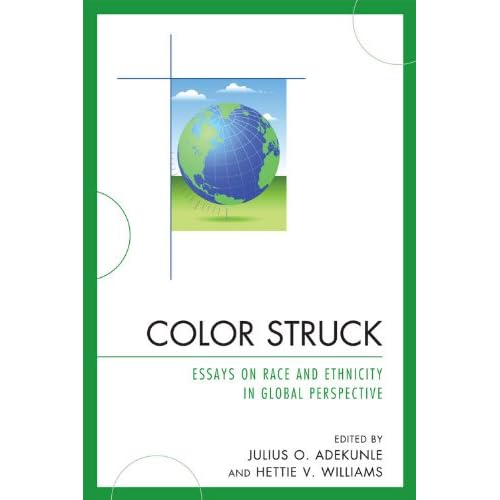Color Struck: Essays on Race and Ethnicity in Global Perspective
University Press of America
April 2010
516 pages
Paper ISBN: 0-7618-5064-3 / 978-0-7618-5064-9
Electronic ISBN: 0-7618-5092-9 / 978-0-7618-5092-2
Edited by
Julius O. Adekunle, Professor of History
Monmouth University, West Long Branch, New Jersey
Hettie V. Williams, Lecturer, African American History
Department of History and Anthropology
Monmouth University, West Long Branch, New Jersey

Color Struck: Essays of Race and Ethnicity in Global Perspective is a compilation of expositions on race and ethnicity, written from multiple disciplinary approaches including history, sociology, women’s studies, and anthropology. This book is organized around a topical, chronological framework and is divided into three sections, beginning with the earliest times to the contemporary world. The term “race” has nearly become synonymous with the word “ethnicity,” given the most recent findings in the study of human genetics that have led to the mapping of human DNA. Color Struck attempts to answer questions and provide scholarly insight into issues related to race and ethnicity.
Table of Contents
Preface
Acknowledgements
Introduction
Part 1: The First Complex Societies to Modern Times
1. Race, Science, and Human Origins in Africa
Julius O. Adekunle
2. Race and the Rise of the Swahili Culture
Julius O. Adekunle
3. ‘Caste’-[ing] Gender: Caste and Patriarchy in Ancient Hindu Jurisprudence
Indira Jalli
4. Comparative Race and Slavery in Islam, Judaism, and Christianity: Texts, Practices, and Current Implications
Magid Shihade
5. The Dark Craven Jew: Race and Religion in Medieval Europe
James M. Thomas
6. Growth of the Atlantic Slave Trade: Racial Slavery in the New World
Kwaku Osei Tutu
7. The Yellow Lady: Mulatto Women in the Suriname Plantocracy
Hilde Neus
Part 2: Race and Mixed Race in the Americas
8. Critical Mixed Race Studies: New Approaches to Resistance and Social Justice
Andrew Jolivétte
9. Militant Multiraciality: Rejecting Race and Rejecting the Conveniences of Complicity
Rainier Spencer
10. Whiteness Reconstructed: Multiracial Identity as a Category of “New White”
Kerry Ann Rockquemore and David L. Brunsma
11. Conversations in Black and White: The Limitations of Binary Thinking About Race in America
Johanna E. Foster
12. The Necessity of a Multiracial Category in a Race-Conscious Society
Francis Wardle
13. Mixed Race Terminologies in the Americas: Globalizing the Creole in the Twenty First Century
DeMond S. Miller, Jason D. Rivera, and Joel C. Telin
14. Examining the Regional and Multigenerational Context of Creole and American Indian Identity
Andrew Jolivétte
15. Race, Class, and Power: The Politics of Multiraciality in Brazil
G. Reginald Daniel and Gary L. Haddow
16. All Mixed Up: A New Racial Commonsense in Global Perspective
G. Reginald Daniel and Gary L. Haddow
Part 3: Race, Ethnicity, and Conflict in Contemporary Societies
17. Black No More: African Americans and the ‘New’ Race Science
Hettie V. Williams
18. Contesting Identities of Color: African Female Immigrants in the Americas
Philomina Okeke-Ihejirika
19. Burdened Intersections: Black Women and Race, Gender, and Class
Marsha J. Tyson Darling
20. Ethnic Conflicts in the Middle East: A Comparative Analysis of Communal Violence within the Matrix of the Colonial Legacy, Globalization, and Global Stability
Magid Shihade
21. Ethnic Identity in China: The Politics of Cultural Difference
Dru C. Gladney
22. Shangri-la has Forsaken Us: China’s Ethnic Minorities, Identity, and Government Repression
Reza Hasmath
23. The Russian/Chechen Conflict and It’s Consequences
Mariana Tepfenhart
Contributors
Index
